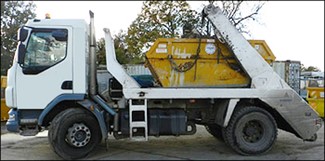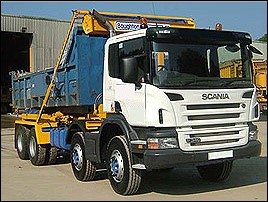Skip & Hook Loaders
This page has been reproduced from the HSE as a note of safety in relation to Hook-loaders and skips loaders. We felt that this article should be highlighted here in the best interest of Safety for the public and also the operators involved in using these vehicles.
Load security when raising and lowering
The Health and Safety Executive (HSE) has become aware of dangerous occurrences during the raising and lowering of waste container skips from hook-loader vehicles. This page highlights the potential for similar failures and action that can be taken.
A mismatch can occur due to the lifting hook slipping behind the hook bar fitted to the container skip, or by the lifting hook connecting to the wrong part of the container framework. The operator of the lifting mechanism is typically located within his vehicle cab during loading and unloading, away from the hook.
Within the UK, historically lifting hooks and container skip hook bars are built to the CHEM (Container Handling Equipment Manufacturers) guidelines. Construction to these guidelines will ensure there is insufficient space within the container skip framework for the lifting hook to pass under and there are no other parts of the skip to inadvertently connect to.


However, it cannot be assumed that all hook-loaders and container skips will be built to compatible standards. Whilst other designs may not be inherently unsafe suppliers, hirers and operators of equipment should ensure that hardware measures, information, instruction and training are provided to control the risks of mismatch.
Preventing 'runaway' skip loader incidents
HSE has recently investigated three instances in which conventional bin type skip Lorries have 'runaway' when lifting skips on slopes.
Investigation of these incidents has found a potential common cause of 'runaway' on a large number of skip Lorries. Where Lorries are fitted with stabiliser legs at the rear of the lifting frame there is the potential to lift the rear wheels off the ground when lifting, negating the effect of rear-wheel braking.
If the vehicle is not braked on the front wheels then it can 'runaway' on the free moving front wheels and the stabiliser legs, particularly if they are fitted with roller wheels.
The risk of 'runaways' can be virtually eliminated by specifying the following when buying new skip loaders:
- All-wheel braking on the subframe of the vehicle, best done before conversion to a skip loader.
- Where all-wheel braking cannot practicably be fitted, flat plates should in provided on stabiliser legs.
On older vehicles:
- Retrofitting all-wheel braking where reasonably practicable, if not then:
- Flat plates fitted to the stabiliser legs.
- All-wheel braking and flat feet on stabilisers are considered reasonably practicable in most cases.
The use of chocks should only be considered in exceptional circumstances and only if they can be used effectively. Their effectiveness depends upon factors such as ground conditions, slope, surface friction, vehicle surge, operator training/ competence and supervision and monitoring.
The following should assist in giving guidance and further information, please use the links below.
Hook loader Vehicles (HSE) - Applicability of Lifting Operations and Lifting Equipment Regulations 1998 (LOLER) - https://www.hse.gov.uk/waste/hookloaderregs.htm
Lifting Equipment at Work – HSE -
Safe use of Skip Loaders – HSE -
Waste statistics in Great Britain, 2020